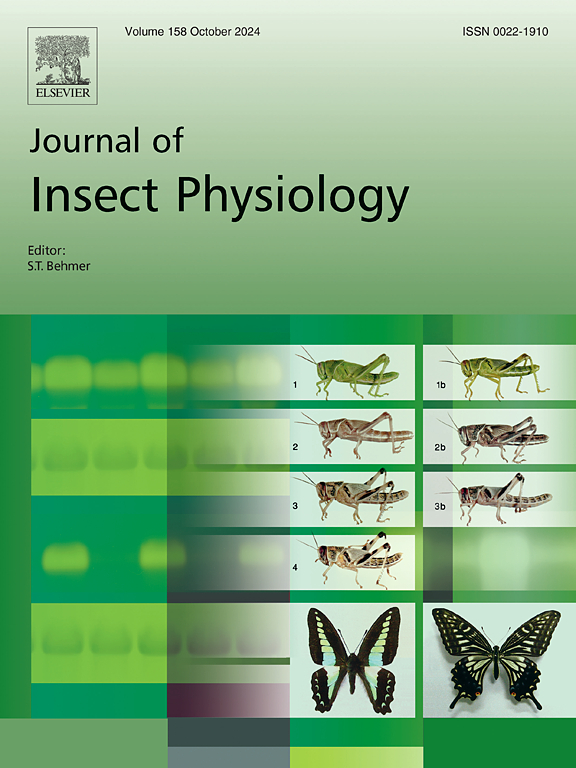Tissue- and temperature-dependent expression, enzyme activity, and RNAi knockdown of Catalase in a freeze-tolerant insect
IF 2.3
2区 农林科学
Q1 ENTOMOLOGY
引用次数: 0
Abstract
Organisms that overwinter in temperate climates may experience freezing and freezing-induced oxidative stress during winter. While many insect species can survive freezing, reverse genetics techniques such as RNA interference (RNAi) have not been used to understand the physiological mechanisms underlying freeze tolerance. The spring field cricket Gryllus veletis can survive freezing following a 6-week fall-like acclimation. We used RNAi to knock down expression of an antioxidant enzyme in G. veletis to test the hypothesis that minimizing oxidative stress is important for freeze tolerance. In fat body tissue, Catalase mRNA abundance and enzyme activity increased during the fall-like acclimation that induces freeze tolerance. Other tissues such as midgut and Malpighian tubules had more stable or lower Catalase expression and activity during this acclimation. In summer-acclimated (freeze-intolerant) crickets, RNA interference (RNAi) effectively knocked down production of the Catalase mRNA and protein in fat body and midgut, but not Malpighian tubules. In fall-acclimated (freeze-tolerant) crickets, RNAi efficacy was temperature-dependent, functioning well at warm (c. 22 °C) but not cool (15 °C or lower) temperatures. This highlights a challenge of using RNAi in organisms acclimated to low temperatures, as they may need to be warmed up for RNAi to work, potentially affecting their stress physiology. Knockdown of Catalase via RNAi in fall-acclimated crickets also had no effect on the ability of the crickets to survive a mild freeze treatment, suggesting that Catalase may not be necessary for freeze tolerance. Our study is the first to demonstrate that RNAi is possible in a freeze-tolerant insect, but further research is needed to examine whether other genes and antioxidants are needed for G. veletis freeze tolerance.

耐冻昆虫过氧化氢酶的组织和温度依赖性表达、酶活性和RNAi敲除
在温带气候下越冬的生物体在冬季可能会经历冰冻和冰冻引起的氧化应激。虽然许多昆虫物种可以在冷冻中存活,但RNA干扰(RNAi)等反向遗传学技术尚未被用于了解耐寒性的生理机制。春田蟋蟀在经过6周类似于秋天的适应后可以在冰冻中存活下来。我们使用RNAi来敲低G. veletis中抗氧化酶的表达,以验证最小化氧化应激对抗冻性很重要的假设。在脂肪体组织中,过氧化氢酶mRNA丰度和酶活性在诱导抗冻性的降样驯化过程中增加。其他组织如中肠和马尔比氏小管在驯化过程中过氧化氢酶的表达和活性更稳定或更低。在夏季适应(不耐冻)的蟋蟀中,RNA干扰(RNAi)有效地降低了脂肪体和中肠中过氧化氢酶mRNA和蛋白质的产生,但对马尔比氏小管没有影响。在秋季适应(抗冻)的蟋蟀中,RNAi的功效依赖于温度,在温暖(c. 22°c)的温度下效果良好,但在凉爽(15°c或更低)的温度下效果不佳。这凸显了在适应低温的生物体中使用RNAi的挑战,因为它们可能需要预热才能让RNAi发挥作用,这可能会影响它们的应激生理。在秋天适应的蟋蟀中,通过RNAi敲低过氧化氢酶对蟋蟀在温和的冷冻处理中存活的能力也没有影响,这表明过氧化氢酶可能不是抗冻性所必需的。我们的研究首次证明了RNAi在抗冻昆虫中是可能的,但还需要进一步的研究来确定是否需要其他基因和抗氧化剂来实现G. veletis的抗冻性。
本文章由计算机程序翻译,如有差异,请以英文原文为准。
求助全文
约1分钟内获得全文
求助全文
来源期刊

Journal of insect physiology
生物-昆虫学
CiteScore
4.50
自引率
4.50%
发文量
77
审稿时长
57 days
期刊介绍:
All aspects of insect physiology are published in this journal which will also accept papers on the physiology of other arthropods, if the referees consider the work to be of general interest. The coverage includes endocrinology (in relation to moulting, reproduction and metabolism), pheromones, neurobiology (cellular, integrative and developmental), physiological pharmacology, nutrition (food selection, digestion and absorption), homeostasis, excretion, reproduction and behaviour. Papers covering functional genomics and molecular approaches to physiological problems will also be included. Communications on structure and applied entomology can be published if the subject matter has an explicit bearing on the physiology of arthropods. Review articles and novel method papers are also welcomed.
 求助内容:
求助内容: 应助结果提醒方式:
应助结果提醒方式:


